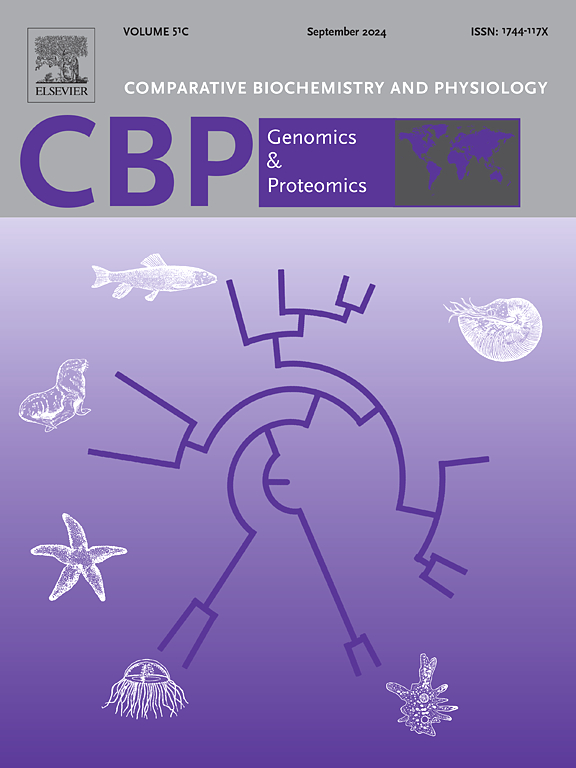Papillae growth and molecular responses in sea cucumber (Apostichopus japonicus) exposed to light spectra
IF 2.2
2区 生物学
Q4 BIOCHEMISTRY & MOLECULAR BIOLOGY
Comparative Biochemistry and Physiology D-Genomics & Proteomics
Pub Date : 2025-05-14
DOI:10.1016/j.cbd.2025.101536
引用次数: 0
Abstract
This study primarily investigated the light spectra that increased the number of papillae in sea cucumbers and the molecular pathways that contributed to the growth of papillae under these light conditions. At 8.0—15.0 °C, sea cucumbers were subjected to a 60-day indoor experiment under different lighting environments (normal, dark, blue light, yellow light, green light, red light, and white light). The number of papillae was analyzed using repeated measures ANOVA, and transcriptome sequencing data of the papillae were subsequently analyzed. The analysis revealed that there were significant differences in the number of papillae within each group at the beginning of the experiment and on days 15, 30, and 45 of light exposure (p < 0.05), while no significant differences were observed within each group between days 45 and 60 of light exposure (p > 0.05). Under blue light exposure, the number of papillae and the increase in the number of papillae in sea cucumbers showed significant differences compared to the control group (p < 0.05). The pathways related to the increase in the number of papillae in sea cucumbers include phenylalanine, tyrosine, and tryptophan biosynthesis and phenylalanine metabolism. The number of papillae increased the most after 45 days of blue light exposure, after which it stabilized. It was speculated that the increase in the number of papillae might be related to amino acid metabolism and collagen synthesis.

光照条件下海参乳突生长及分子响应
本研究主要研究了在这些光照条件下海参乳头数量增加的光谱以及促进乳头生长的分子途径。在8.0 ~ 15.0℃条件下,对海参进行60天的室内光照环境(正常、暗光、蓝光、黄光、绿光、红光、白光)试验。使用重复测量方差分析分析乳头数量,随后分析乳头转录组测序数据。分析显示,在实验开始时和光照15、30、45天,各组乳突的数量有显著差异(p <;0.05),而光照45天和60天各组间无显著差异(p >;0.05)。在蓝光照射下,海参的乳头数量和乳头数量的增加与对照组相比有显著差异(p <;0.05)。海参乳头数量增加的相关途径包括苯丙氨酸、酪氨酸和色氨酸的生物合成和苯丙氨酸的代谢。在蓝光照射45天后,乳突数量增加最多,之后数量趋于稳定。推测乳头数量的增加可能与氨基酸代谢和胶原合成有关。
本文章由计算机程序翻译,如有差异,请以英文原文为准。
求助全文
约1分钟内获得全文
求助全文
来源期刊
CiteScore
5.10
自引率
3.30%
发文量
69
审稿时长
33 days
期刊介绍:
Comparative Biochemistry & Physiology (CBP) publishes papers in comparative, environmental and evolutionary physiology.
Part D: Genomics and Proteomics (CBPD), focuses on “omics” approaches to physiology, including comparative and functional genomics, metagenomics, transcriptomics, proteomics, metabolomics, and lipidomics. Most studies employ “omics” and/or system biology to test specific hypotheses about molecular and biochemical mechanisms underlying physiological responses to the environment. We encourage papers that address fundamental questions in comparative physiology and biochemistry rather than studies with a focus that is purely technical, methodological or descriptive in nature.

 求助内容:
求助内容: 应助结果提醒方式:
应助结果提醒方式:


